How to Tell Nobel Winner Nadia Murad’s Story Without Trading on Her Pain
Director Alexandria Bombach tells Truthdig how she avoided exploiting her subject's traumatic past in making her new documentary, “On Her Shoulders.”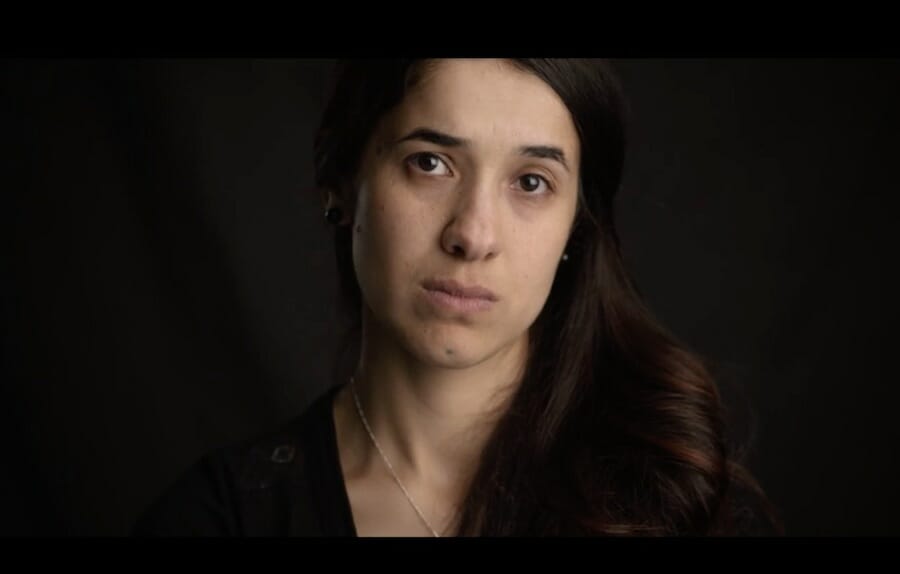 Another close-up: Nadia Murad sits for the cameras in a scene from Alexandria Bombach's documentary, "On Her Shoulders." (OnHerShouldersFilm.com)
Another close-up: Nadia Murad sits for the cameras in a scene from Alexandria Bombach's documentary, "On Her Shoulders." (OnHerShouldersFilm.com)
What does it take, in an era wracked by war and trauma, to get the world’s attention? Put another way, whose suffering is worthy—of airtime, relief, simple notice?
Our collective field of vision is already crowded with images of bombed-out zones leveled by man-made, natural, and man-made natural disasters. From them springs the endless footage of refugees—pouring into tent cities, spilling over dinghies, shuffling into makeshift jails at U.S. border towns—their anguish clear even if its cause is obscured. If it weren’t for the unholy synergy between media barons, pundits and politicians who no longer bother with such stuporous relics as conflict of interest or deliberative democracy while staging their cage matches, there would be little else to see on the news.
Meanwhile, the arena of nonprofits, NGOs and aid organizations has become infused with flash as well as cash, as concepts that read like oxymorons—venture philanthropy, celebrity advocacy, billionaire benefactor—not only track but sell big in an economy in which both money and attention count as currency. Seems like it takes a skilled team of media handlers, not to mention the backing of the United Nations and at least one worried ambassador from Hollywood, to even register on the scale of global crisis.
For her part, Yazidi refugee-turned-activist Nadia Murad had access to all of the above. She found high-profile help in the form of her lawyer, Amal Clooney, plus support from international agencies, governments, and filmmaker Alexandria Bombach, whose documentary “On Her Shoulders” takes the 24-year-old crusader as its focus. Murad’s campaign to save family and community members under the control of Islamic State propelled her on an international speaking tour and into some of the world’s most exclusive spaces—Davos, Canada’s Parliament Hill, the U.N.
It also made her into a reluctant kind of star whose fame, judging by many of the interviews and encounters she endures in “On Her Shoulders,” appears to depend upon the degree to which she has suffered. Murad is asked to tell her story over and over again in horrifying detail: how some 18 members of her family, including her mother, had been killed or were missing since Yazidis in Iraq and Syria were targeted for genocide in 2014 by Islamic State. Other hot topics for her interviewers include how long she had been enslaved, just how many times she was violated by her captors, and how she had escaped. Murad has other, forward-looking questions in mind that she wishes she would be asked instead, such as: “What must be done so Yazidis can have their rights?” Those close to her mention how telling her story takes a piece of her every time.
As Murad’s own form of fame grows along with the crush of onlookers, foreign dignitaries and well-wishers in her personal space, Bombach follows along with her camera at a respectful remove. An accomplished cinematographer and editor as well as a director, Bombach (in contrast with not only those around Murad, but also with many other documentary filmmakers) practically disappears from the film as she zooms in on Murad, taking care not to exploit her even when recording her in states of acute distress. The result is still a strikingly intimate portrait that invites viewers to notice, as Bombach plainly did, Murad’s vulnerability as well as her grit. In one memorable scene, Murad allows herself the mundane pleasure of picking out a dress with a gauzy skirt that spins nicely when she twirls—and yet it’s a black dress in a store full of colors.
In another, side-by-side conversations play out between two pairs of people watching Canadian soldiers run through drills on what seems like a mellow afternoon. On the right, Murad watches solemnly with Murad Ismael, her devoted helper and executive director of the Yazidi advocacy group YAZDA; on the left, two Western women smile and laugh as they chat, clearly having a very different experience of the military display before them. Murad remarks about how a soldier in her homeland would have blown himself up by that point in the exercise. Ismael agrees, offering that certain parts of the world are “hell for no reason.”
The same global flows—of information, technology, displaced bodies—make for just these situations, in which two parties briefly share the same space at the same time, with varying degrees of mobility and very different prospects once they leave, if they can leave. Now a Nobel Peace Prize winner, Murad has become an expert in managing such contradictions, as she is greeted with awe and awards in the same rooms where decisions are made that spark the conflicts that affect millions of lives like hers. But she keeps going, taking their questions and photos, talking about her home—because that’s what she can do to get the world’s attention.
Bombach recently spoke with Truthdig as she began her press tour for “On Her Shoulders.” She won an award for documentary directing at the 2018 Sundance Film Festival, and the film’s message is no doubt signal-boosted, along with Murad’s own, by the news of the Nobel prize. Judging by how Bombach approached this project, though, the fanfare factor seems to be a bit beside the point for her, too.
Kasia Anderson: My first question, to take it from the beginning, is how you became aware of the subject, of Nadia and her story, and how the project came together.
Alexandria Bombach: RYOT, the production company, reached out to me in the middle of July of 2016 and said that they had gotten the [go-ahead] to do a documentary about Nadia. They wanted to make a short film, and they had seen my work and [we had] worked together. So, it wasn’t even two weeks after that that I flew directly to meet Nadia and Murad [Ismael]. I packed my bags actually to go be in Kurdistan for a month, but as soon as I got there, they said they were going to Canada instead, which kind of threw me for a loop.
But it was pretty instantly that I could feel just who Nadia was and who Murad was and what they were doing and the nature of the work, and that the character of this was going to be a much more complicated story than could fit into a short. So I advocated from the beginning for it to be a feature and ended up making the film in secret for a while in post-production because the production company hadn’t made a feature yet before and just wanted to make a short. Thankfully, after I showed them the feature … they were convinced. So that was a little risky, but it turned out well in the end.
KA: Had you been aware of the Yazidis’ story from 2014 at that point? How quick of a study did you need to do once you knew what you were going to be tackling?
AB: I definitely knew all about the genocide in 2014. I had been following that whole thing that happened on Sinjar Mountain … most of my work has been in Afghanistan; I’ve been pretty focused on the region. But I remembered seeing Nadia on that Facebook video in 2015 doing her speech at the U.N. Security Council, and that was in December 2015—just eight months before I met her in person. And the film I made in Afghanistan was definitely a film about storytellers, about Afghan photojournalists. I’m really interested in stories and how we tell them and who gets to tell them and our perspective, and I was very interested in working with Nadia on this film because there’s a lot to be said for how we package stories of trauma and are treating them and sensationalizing them. We’re really just taking a critical look at advocacy.
KA: Right, and there is a definite sense from the viewer’s point of view, or at least this viewer’s point of view, that unlike some documentaries, your presence as the filmmaker is not as palpable. I’m wondering how you approached your role in telling her story.
AB: Well, immediately after meeting her, I saw her preparing for a speech and having conversations about what was important in that speech, and that was an interesting behind-the-curtain look at trying to get people to listen to a story. Then [we] went to Canada, and I pretty immediately saw the interview that she was doing with CBC. And that struck me really hard because I have a little bit more a different role, in a lot of ways, than a journalist does in how I’m approaching story and what I’m able to do as an independent documentary filmmaker.
And, you know, I don’t think that it’s black or white, or that that interview was damning against the CBC—I actually felt like that was one of the more gracious interviews. But it was completely eye-opening in the questions that they felt they needed to ask and seeing it take the toll in front of my eyes on Nadia and realizing how much she had done that in the past and how much was ahead of her. It made me really question everything about what we are doing as storytellers and our responsibility towards stories of trauma, especially when asking survivors of such an intense trauma to repeat their stories, and what our responsibility is. So, in a way, that question is not just for journalists but also for myself and was a huge reason why the film is shaped the way it is.
KA: In light of how you saw journalists handling her story and—either by default or by the questions they were choosing—how they were positioning themselves, was there anything that you decided that you would not include in the documentary?
AB: Yeah, I mean, I think that was a week into shooting, and I knew pretty immediately that I would not be putting her through one of those interviews and that that was not necessary, and that I did not want to focus on the story of her captivity or her escape. And I think a big part of the film is I want people to be questioning why they even need to know that in the first place. Where that want is coming from and how disturbing that actually is. First it was like wanting to know what can be done and what the next steps are for Yazidis, especially given that there are still women in captivity.
I think the whole film for me was … people go in thinking that this is a film about Nadia, but for me and for a lot of people, it’s a film about us and how we’re reacting to a lot of stories of trauma. But there’s a fatigue around the migration crisis and the refugee crisis, and I think the storytelling has kind of been on a difficult path where people are trying to grab attention through sensationalism. And that can be a very dangerous way to teach people how to be interested in what’s going on around the world.
KA: Right, because it also puts a premium on trauma in a way, in that if some kind of narrative like that is not in someone’s personal history, then do they get the floor in the same way?
AB: It’s interesting, too, that—this was a pretty good example of it that was cringe-worthy to me—that people were really focused on and wanted to know exactly how much time she was in captivity. To weigh against other women. That kind of stuff was blowing my mind. I was very shocked at the world I was entering into and how they had to basically figure out how to market, use marketing as a tool. But that’s not just them; that’s what they’ve been guided to do and became a larger reality—bringing people like Luis Moreno Ocampo into the film and Amal Clooney—it’s the world that they had to navigate.
KA: Right—a bit about the Amal Clooney element, if I could call it that for shorthand purposes, in a minute—but I wonder if you got a sense for what parts of Nadia’s story she felt were the most important as opposed to what she seemed to get the most questions about?
AB: I think … I don’t know—I couldn’t speak for Amal, but I think it was apparent from the interviews that I see with her that she’s very conscious of trying to navigate away from questions about George and putting Nadia at the forefront but also very aware of her power as a celebrity. And she’s a brilliant human being who navigates that very well and uses that power for good in a lot of ways, but … I don’t know exactly how she feels about specific questions.
It’s interesting to me, and I think that Amal is just incredibly brilliant, and I know that Nadia and everyone is very thankful for her attention on this case and her continued work on it, but it’s up to me as a filmmaker to give a bigger-picture look. It’s so sad—the same reason that Amal Clooney is so powerful is kind of the same reason that nobody cares about the genocide [of the Yazidi people]. It’s just on an opposite spectrum of celebrity-ism and that fame, and people are just not caring about this marginalized community unless [Nadia’s] involved with someone like Amal. It’s a bad state of affairs, but at the same time, I’m very thankful. … A big part of the film is kind of pointing out good intentions but also just how wrong those can go sometimes or feel very tactless—just like, you know, people wanting to take pictures with Nadia in the Parliament hall or … it’s like good intentions gone astray.
KA: Yes, and some of that is out of the hands of people who have the intentions. That’s something I think you captured very well.
There was that whole Davos and Tina Brown vignette with Tina Brown hosting and Amal Clooney bringing Nadia into that setting, and there’s this juxtaposition of this world of glamour and fashion onto these really intense, acute humanitarian crises, and how that all comes together … or not.
AB: One thing that gave me a little bit of peace, at least about Nadia’s specific experience of having to tell her story over and over again, is the fact that she was, and is, still so interested in makeup and hair. And there was something—I mean, obviously, she’s so sharp and very aware and conscious and smart about people trying to exploit her story now and navigating that in such a better way, and I’m really proud of her for really owning that stuff, but I think she really does love the fashion of Amal. Amal’s makeup person actually was training Nadia in New York for a couple days and just giving her a little bit of a break. …That’s a whole other layer of observing all this and trying to absorb it and being like, wow, that’s actually something that Nadia loves—you know, that side of it.
KA: And that scene in which you capture her with her new dress after trying on clothes, and as a viewer it was like a sigh of relief—here’s someone who gets a moment of just aesthetic enjoyment which is kind of like a little glimmer of “normalcy” in all the other really heavy stuff that she’s constantly having to move around in, live her life in the midst of …
AB: Exactly, and this is a really subtle thing, though: She was looking for a black dress. I don’t know if people pick up on that. She was in a room full of all these colorful clothes, and feeling very out of it, and Nadia, especially when I was with her, never wore anything but black out of survivor’s guilt … and respect. But she bought a dress, and she was happy about the way it looked, but it was a long, black, very conservative dress. I’m sure she would love to burst out in, like, a pink dress.
KA: It had a little bit of a floaty fabric to it, though, so at least there was that.
AB: Yeah, it was really powerful to see her come out in it and kind of wave it around.
KA: So, you’ve mentioned the journalistic side of things—how about global bodies like the U.N. who seemed very invested in hearing Nadia and sponsoring her and having her sponsor them—works both ways—and then the special session is no longer in meeting, and she’s moved on and they’ve moved on to other engagements. What has been the response of those Canadian Parliament members who have heard her out—what now? What has the follow-up been?
AB: It seems to be a very slow-moving train, and different objectives come to light that seem to be the most important thing and then fall away—something else seems to become really important. I know that Nadia’s and that investigative team that was created by the U.N. was a huge point for them, a turning point, it took them a really long time to send out the team. I think it was only about a month and a half ago or something like that when the team was actually sent out to investigate these gravesites and assess the atrocities. I hear stuff daily … some days I’ll hear really great things from one person, and the next day it’s someone else telling me that all of that was not really that important, so it’s hard for me to assess from afar.
The thing that I do know is that Nadia has completely shifted her work into focusing on the Sinjar Action Fund, and she has her own initiative now called Nadia’s Initiative, and the meetings that she’s taking are very specific. She’s not doing interviews like she was before. She’s choosing specific stuff, which is great. And the whole goal of the Sinjar Action Fund is to get people back into Sinjar, and for there to be security and infrastructure put back in. ISIS was planting mines when they were leaving; de-mining is a huge part of her work now. In one of the last shots [in the documentary], she was shaking hands with [French] President [Emmanuel] Macron, and that was a really big turning point as well, because the French government is hopefully putting a lot of weight behind that de-mining process, and hopefully getting other European countries on board with it.
KA: Do you, either consciously or since you wrapped filming—do you see the documentary itself as a form of advocacy?
AB: I would hesitate to say that just because I’ve been personally been questioning. … I mean, a lot of people want to dump documentary into the advocacy of awareness, and as a human being and as a storyteller I’m kind of questioning that whole line of thinking. Because it doesn’t really matter if a soccer mom in Texas is more aware of the Yazidis—she can’t do anything to help them. I think there is a consciousness of awareness that I want people to have that thinks more critically about the simplification of stories and charity and our understanding of, you know, countries in the Middle East and putting women up on pedestals in order to feel better about ourselves and that situation—there’s a lot to unpack there.
But as far as the Yazidis, there are specific screenings that I know people who work with Nadia are very happy to have at the U.N. and in Vienna and New York and with certain funders. I hope that this can raise money for specific causes. But as far as a more typical call to action or something like that for the public, no, I don’t think this film is that. I’m trying to get people not to see it that way, because I think that’s one of the problems. There’s some tropes and tendencies of putting Nadia in a position where she’s almost like a Malala [Yousafzai], and I think that’s really problematic.
KA: I agree about the awareness factor—it’s kind of a squishy term, and it’s hard to know what that term means—you can’t quantify it, and so forth.
AB: Yeah, and it’s kind of forgiving all sins right now. …
KA: Exactly. Along celebrity lines, my last question is whether it seemed to you that it’s necessary for people who want the proverbial mic or the platform on a global scale right now—that they need to either be celebrity-adjacent or made into a kind of celebrity themselves in order to be granted access to certain spaces, in order to be heard in a certain way.
AB: I mean, I think it’s a hard question because it’s putting such a responsibility all on them. I think that questioning our own way of how we’re telling stories and how we’re listening and how we’re accessing empathy about such traumatic things. Also, I want to stop looking at [celebrities] and instead have people focus on the U.N. and the justice system and the ICC turning down this case, and seeing how are we holding people accountable versus just telling stories for sensational reasons. I hope that we’re turning the camera the other way and being like, why are we doing this at all? Why is this system even existing?
As far as recommendations to people trying to have a voice, it terrifies me, especially coming from working and making films in Afghanistan for a long time. People have such fatigue around these issues and are addressing them in certain ways. That’s a super-complex question, and I hope someone watching this film will tell me the answer.
Editor’s note: This interview has been edited for brevity and clarity.
Your support matters…Independent journalism is under threat and overshadowed by heavily funded mainstream media.
You can help level the playing field. Become a member.
Your tax-deductible contribution keeps us digging beneath the headlines to give you thought-provoking, investigative reporting and analysis that unearths what's really happening- without compromise.
Give today to support our courageous, independent journalists.
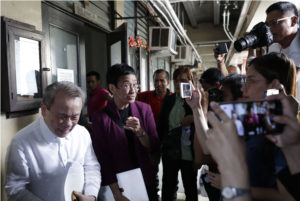
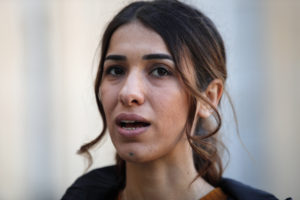
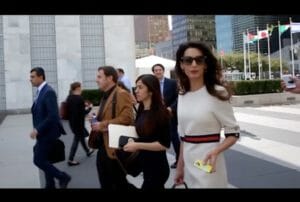
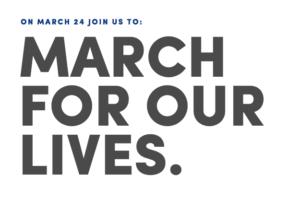
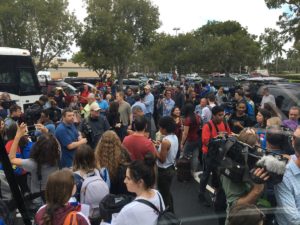
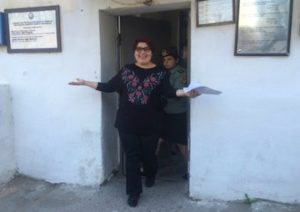
You need to be a supporter to comment.
There are currently no responses to this article.
Be the first to respond.